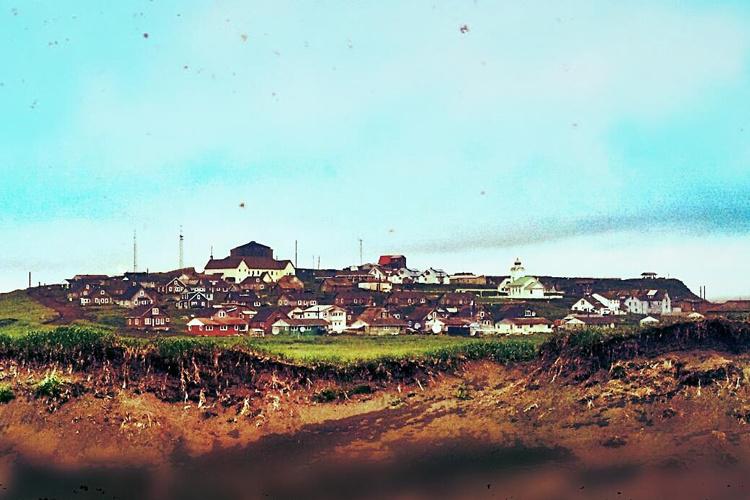The In-Between
For those of us in fisheries science, there’s a lot of in-between. Our field season lasts about 3 months each year, so we have 9 months of in-between to process data from the previous field season and prepare for the next one.
There’s an in-between as we rotate scientists on and off of boats (we break a survey down into multiple “legs” and a new group of scientists replaces the scientists on the previous leg, a typical leg lasts a few weeks), which is happening right now with Bob disembarking the Vesteraalen and Dan Nichol taking his place, and in-between, I’m taking Bob’s place writing this blog… hello, this is Jason. Later this week, I’ll be travelling up to the Vesteraalen for Leg 3.

The map shows the sampling grid for the 2017 eastern and northern Bering Sea shelf bottom trawl survey (June 1 and August 30, 2017). The map will be updated several times each week to show the progress of the survey vessels and the bottom temperature (°C) in each 20x20 nautical mile grid cell.
The most difficult in-between we experience may be the in-between of leaving our homes to travel to the boat and vice versa. Last week, scientists were meant to fly to St. Paul in the Pribilof Islands, but were delayed for several days in Anchorage because the island was shrouded in cloud cover. The time window for changing crew is only open for as long as there are stations to be sampled in the area (see map). Meanwhile, outgoing scientists are kept in-between on the boat or on the island, wondering if they will make it back home to commitments left on shore, such as family events, office responsibilities, etc.
Even when travel goes smoothly, there is a cultural in-between of going to sea and coming back home. Living and working on a boat increases certain sources of stress on body and mind, but also alleviates stressors we come to take for granted on land. So whether we are coming or going, an important aspect of being a fisheries scientist is adjusting as effectively as possible, and to be comfortable with all of the in-betweens.
Third Leg of Survey Begins
To everyone on Leg 2, congratulations and thank you for all your hard work!
The FV’s Vesteraalen and Alaska Knight returned to Dutch Harbor on 13 July, refueled, provisioned and the new scientific crew all finally made it in. The charter vessels departed the afternoon of 16 July and were on station beginning survey operations today.

The fishing and scientific crew aboard the FV Vesteraalen on Leg 2 of the Survey. From left: Steve Elliott (Vesteraalen), Andy Wenger (Vesteraalen), Elaina Jorgensen (AFSC), Glen Jahnke (Vesteraalen), ), Alec Mavar (Vesteraalen), Bob Lauth (AFSC), Robert Foy (AFSC), Chris Clarke (IPHC), John Andres (USCG), and Patricia Puerta (OSU).

The fishing and scientific crew aboard the FV Alaska Knight on Leg 2 of the Survey. From left: Lyle Britt (AFSC), Shawn Russell (Alaska Knight), Chris Long (AFSC), Duane Stevenson (AFSC), Christine Kircun (NEFSC), Kevin Adams (Alaska Knight), Susan Parker (Alaska Knight), Tyler Jackson (ADFG), Christian Willis (Alaska Knight), Elizabeth Perkins (AFSC), Edgar Tubera (Alaska Knight), and Mike Ruff (Alaska Knight). Add a description
Meet the Bloggers

Bob Lauth
Bob Lauth has been a Fisheries Research Biologist for the NOAA Alaska Fisheries Science Center in Seattle for 26 years. Bob leads the Bering Sea Group, which is responsible for conducting summertime surveys of bottom fish, crabs, and other bottom-dwelling creatures in the offshore marine waters of Alaska. Fascinated by Jacques Cousteau as a kid, Bob moved from Chicago to the 'ever-green' Seattle in 1980 to become a marine biologist without the slightest idea how to earn a living. After working three years in a dive store, teaching scuba diving, and doing marine field trips with school kids in the Puget Sound, Bob learned about the 'fishy side’ to marine biology. He enrolled at the University of Washington School of Fisheries, earned a Master’s degree, and then worked for the Inter-American Tropical Tuna Commission at a remote marine lab in Central America before returning to the northwest with his wife to raise a family and pursue his career in fisheries.

Jason Conner
Jason Conner is a fishery biologist who researches the groundfish populations of the Bering Sea. He began his career with NOAA Fisheries in Woods Hole, MA, at the Northeast Fisheries Science Center, helping to record data on whale and seal populations in the Atlantic. He also spent two years in Gloucester, MA, working on fisheries data reporting systems for the Northeast Regional Office. Jason grew up in Denver, CO, but he has had a passion for the ocean since he was two years old. In his free time, Jason enjoys acting in community theater, playing ice hockey, and diving (with and without SCUBA).



